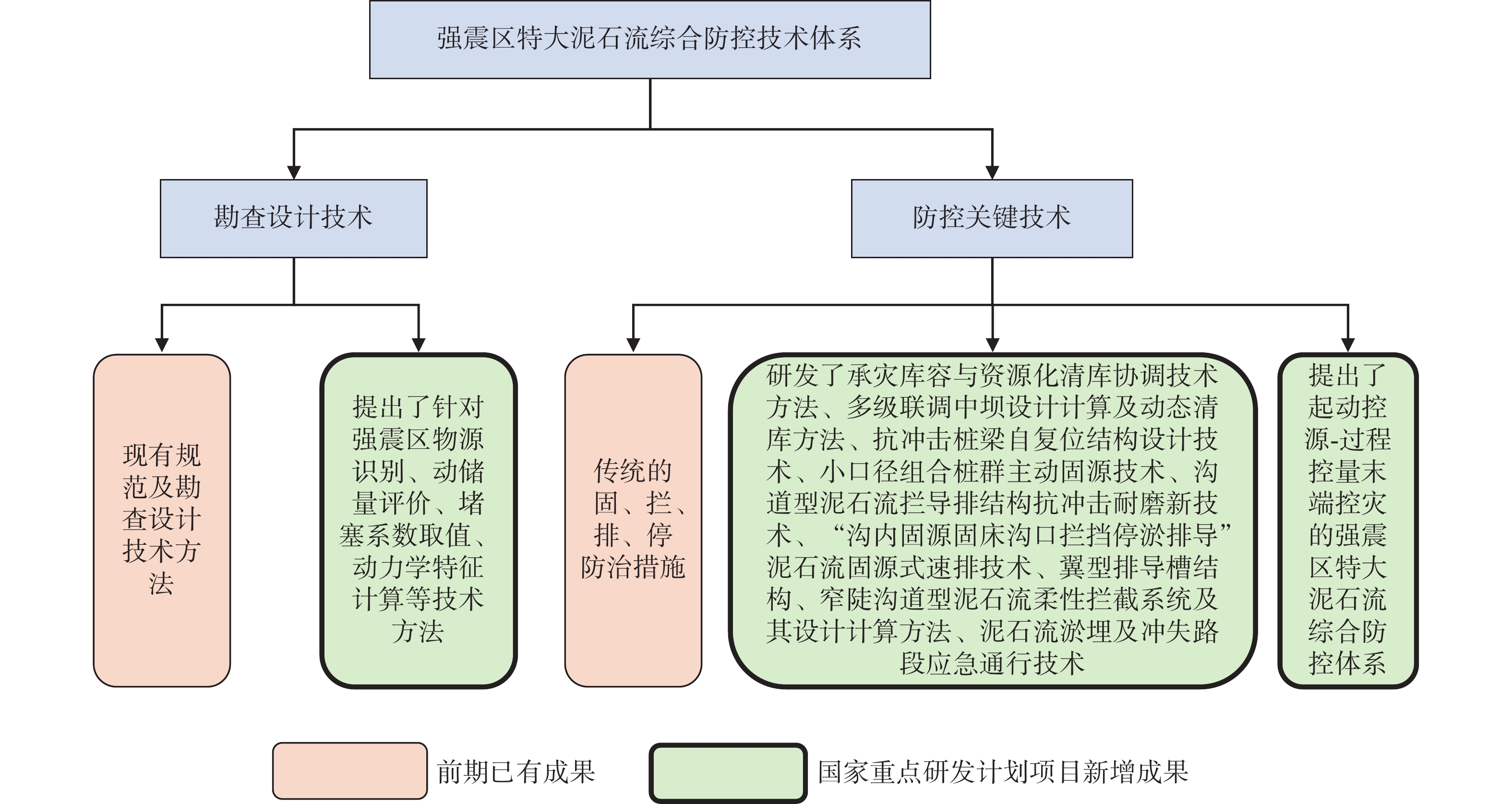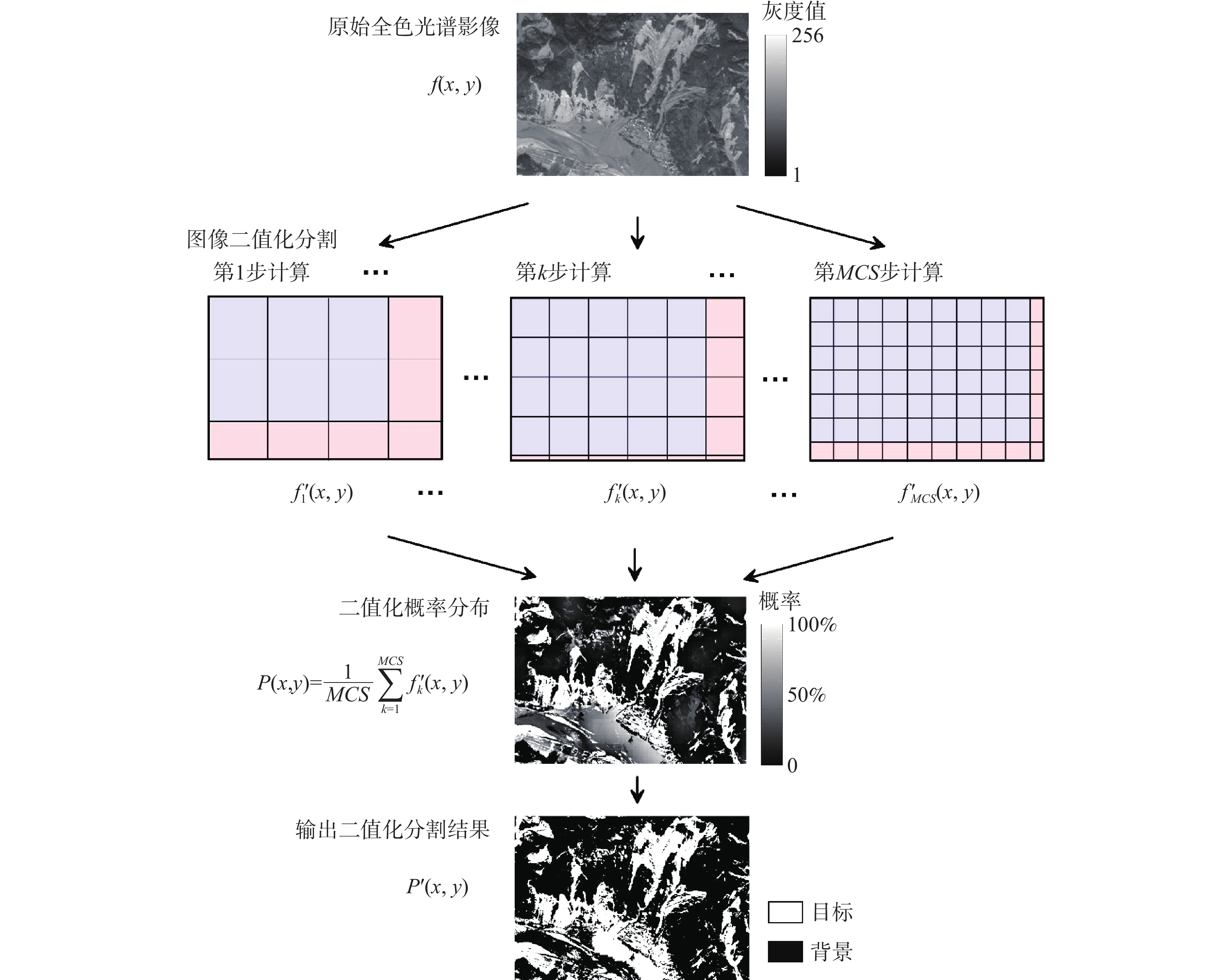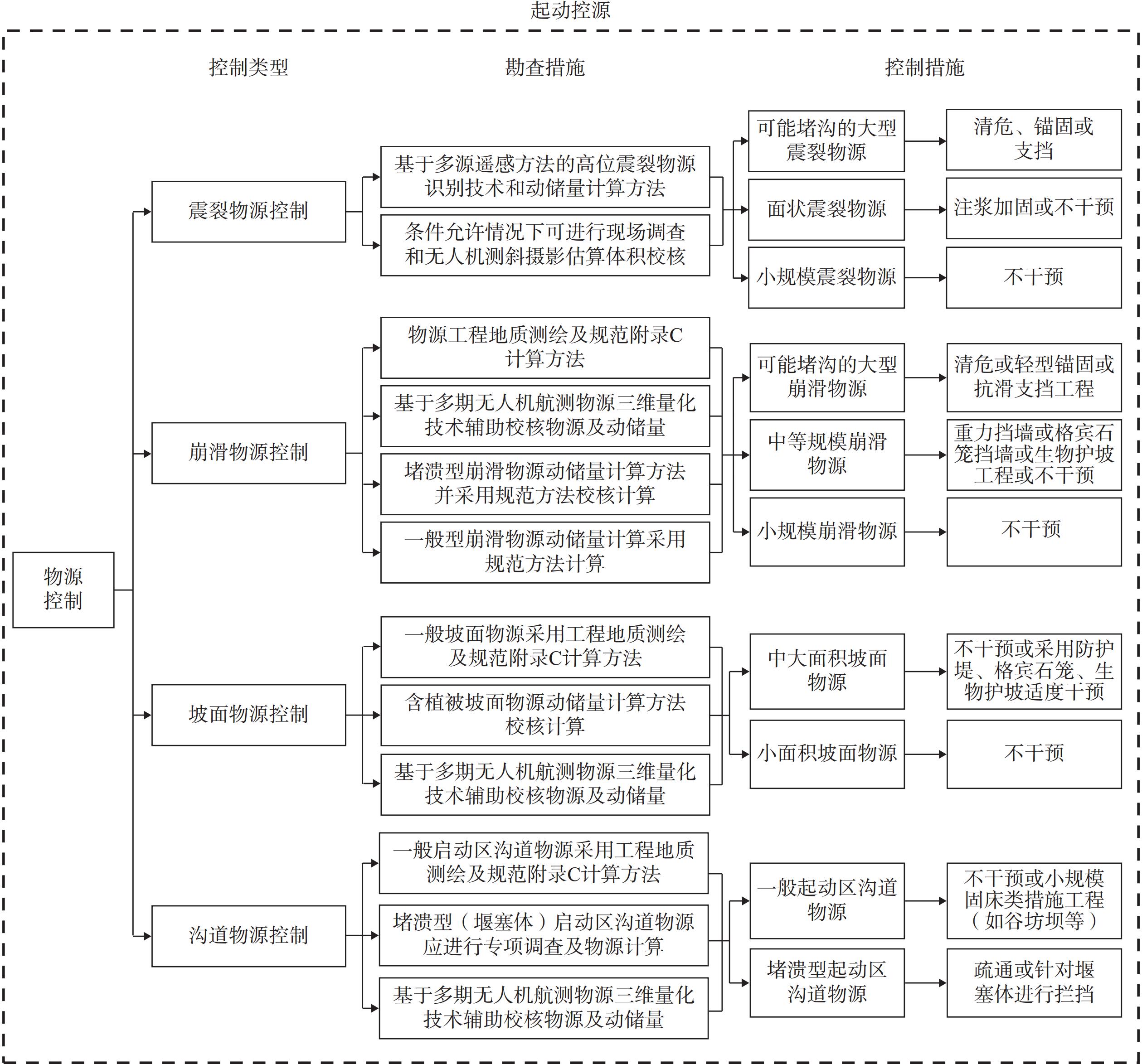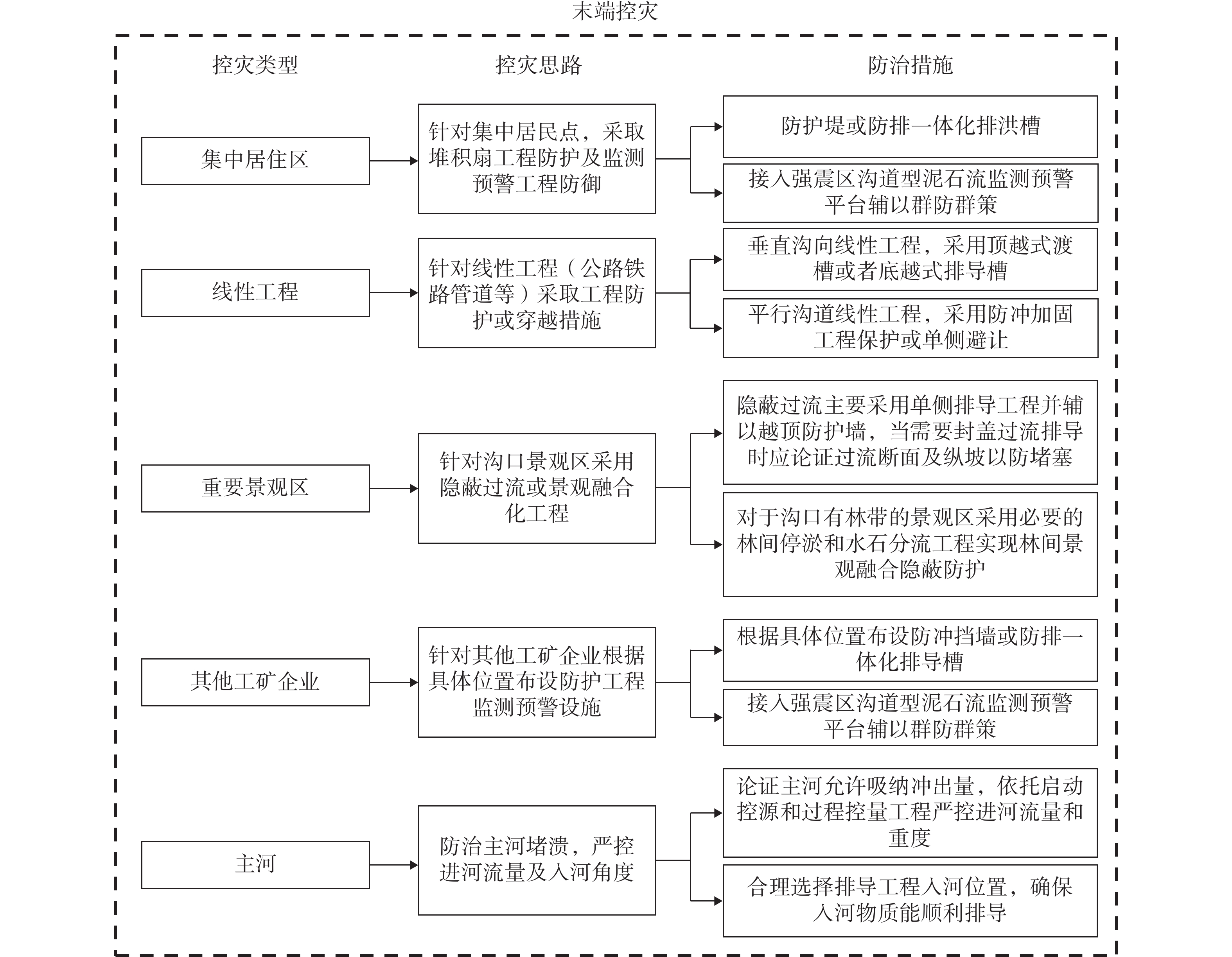Research on the comprehensive control technology system of large-scale debris flows in the area affected by strong earthquake in Longmenshan, Sichuan Province
-
摘要:
强震区泥石流表现出群沟暴发、范围广、持续时间长、规模大、危害重、防治难等特点,文章以强震区数十条典型特大泥石流沟为研究对象,采用野外调查、分析统计、试验验证及示范工程应用等方法,开展了典型泥石流沟特点及其防治工程效果研究,构建了强震区特大泥石流综合防控技术体系,形成了强震区特大泥石流勘查设计技术和防控关键技术体系。勘查设计体系在现有勘查技术基础上提出震裂物源识别新技术、堵塞系数分项取值新思路等;根据泥石流沟谷形态将强震区泥石流分为窄陡型和宽缓型;防控关键技术体系针对不同沟谷形态的泥石流分别进行综合防控关键技术探讨实践,统筹考虑了窄陡型和宽缓型泥石流沟上游、中游、下游沟谷特征。组合多种综合防控措施,建立了“起动控源→过程控量→末端控灾”逐级控制的强震区特大泥石流综合防控体系。结果可为强震区泥石流综合防控提供技术支撑,也可为非震区泥石流综合防控提供参考。
Abstract:In response to the challenges posed by frequent, widespread, long-lasting, large-scale, severe, and difficult-to-control debris flows in strong earthquake areas, this study, based on the results of the National Key R&D Program, investigates dozens of typical mega debris flow gullies in these regions. Through test verification and demonstration engineering application, the characteristics of typical debris flow ditches and their prevention and control engineering effects were studied, leading to the construction of a comprehensive technical system for the prevention and control of mega debris flows in strong earthquake areas. A key technical system for exploration, design, prevention, and control of mega debris flows in strong earthquake areas was formed. The exploration and design system introduced new technologies for identifying earthquake-induced fracturing sources and novel approaches for determining blocking coefficients based on existing exploration technologies. According to the morphology of debris flow valleys in seismic areas, debris flows are classified as narrow and steep or wide and gentle. The key technology system for prevention and control was established to comprehensively discuss and practice key technologies for preventing and controlling debris flows in different valley morphologies. Considering the characteristics of debris flow valleys in the upper, middle, and lower reaches of both narrow and steep or wide and gentle debris flow valleys, a combination of various comprehensive prevention and control measures was proposed. This led to the establishment of a hierarchical control system for major debris flows in seismic areas, from controlling the source to the process and ultimately mitigating disasters. This system not only provides technical support for comprehensive prevention and control of debris flows in seismic areas but also serves as a reference for comprehensive prevention and control of debris flows in non-seismic areas.
-
0. 引言
四川省汶川县“5•12”特大地震发生后,强震区连续多年暴发特大泥石流,表现出群沟暴发、范围广、规模大、持续时间长、危害重、防治难的特点,给灾后重建和灾区人民造成极大危害。据初步统计,“5•12”震区44个重灾县(市)发育有潜在泥石流沟836条,其中潜在的巨型泥石流沟90条、大型泥石流沟91条、中型泥石流沟300条、小型泥石流沟355条。威胁到不同规模的城镇或乡镇近百个[1]。
震后泥石流的物源调查、运动规律、成因机理、起动模式以及排导槽耐冲刷抗磨蚀等方面,国内外学者进行了大量研究,著作颇丰[2 − 5]。泥石流物源是泥石流形成的三大条件之一,震后沟道内泥石流物源总储量异常丰富,动储量逐年增加,泥石流暴发临界降雨量显著降低,暴发频率增强,沟道内物源储量与冲出固体量存在幂函数关系[6 − 9]。乔建平等[10]将汶川地震灾区的泥石流物源分为三种类型。赵松江等[11]认为震后泥石流物源类型及特征与常规泥石流有较大差别,并将九寨沟地震后泥石流物源分为崩滑型、沟道冲刷型和坡面侵蚀型物源。泥石流运动规律、成因机理复杂,起动模式多样。前人研究将起动模式主要归纳为“归流拉槽、深切揭底、堵塞溃决”三种孕灾模式[12 − 14]。
泥石流作为一种多相混合介质,运动过程非常复杂,随着数值计算方法和物理计算模型的发展,数值模拟方法在探究泥石流运动模式方面得到广泛应用。陈多鸿[15]利用基于SPH-DEM-FEM耦合的三维泥石流动力过程进行模拟研究,论证了耦合数值分析方法用于泥石流动力过程模拟的合理性。杨帆[16]利用泥石流冲击工程结构动力过程的三维流固耦合数值分析方法,验证了数值方法在泥石流冲击力研究方面的适用性和合理性。张福红[17]通过基于GPU加速的SPH方法溃坝水流数值模拟研究,得到梯形障碍物块体消能效果最好,消能效率为14.154%。Gregorio等[18]利用CA模型对泥石流、滑坡等复杂自然灾害系统的演变过程进行了深入研究, 刘亚敏[19]利用元胞自动机模型建立突发自然灾害模拟与预警系统,对于灾害的防治工作具有极大的应用价值。赵莉等[20]在元胞自动机模型研究中指出,元胞自动机在多个领域的研究成果证明其有广阔的研究领域和重要实践意义。
近年来,全球范围内高位隐蔽滑坡型泥石流链式灾害造成多起群死群伤事件和重大经济损失,多位学者对其进行大量研究,并建立早期识别方法,探讨分布特征、变化趋势及防治措施。通过对金沙江白格滑坡及茂县叠溪镇新磨村等高位滑坡进行分析,提出对高位隐患应早期识别和提前发现,尽快推广应用现代高精度对地观测技术,对高位崩滑灾害隐患进行主动排查和防范[21 − 27]。殷跃平等[28]通过对高位远程地质灾害研究,揭示了高位滑坡碎屑流势流体链动传递机理,紊流体和犁切体的边界层效应,提出改造高势能碎屑流体的边界层底坡、增大湍流边界层内湍动能的生成与组合障桩前死区范围的消能降险方法。并提出了易灾地质结构孕灾机理、高位远程链灾动力过程和风险防控理论与技术等研究方向。
泥石流治理工程磨蚀损坏是导致治理工程失效的重要原因之一。国内外学者将泥石流治理工程磨蚀损坏后磨蚀形貌分为4类,并得出浆体黏度相同时治理工程磨蚀程度与泥石流固体物质比例呈正相关;固体物质比例相同时,磨蚀程度与浆体黏度呈负相关。构建了泥石流两相冲击力的综合表示式,建立了泥石流冲击时间计算方法,测定了泥石流对大坝护坦的磨蚀程度[29 − 33]。何胜庆等[34]通过对高海拔地区宽级配泥石流冲击拦砂坝试验研究得出,宽级配泥石流容重越小,爬高越大,且拦砂坝的坝前冲击力随宽级配泥石流容重的增大而减小,随沟槽坡度增大而增大,随宽级配泥石流固相最大粒径增大而增大。
综上,震后泥石流的物源、机理、参数、结构等方面,国内外学者进行了大量广泛的研究,但强震区泥石流综合防控技术体系的研究相对较少。强震区泥石流数量多且规模大,区内多数泥石流沟首次治理工程失效,进而开展了数次工程治理。究其原因一是对强震区特大型泥石流成灾机理认识不清,导致震后泥石流首次治理设计缺乏机理分析及针对性;二是对强震区泥石流动力学特征参数计算不准,严重影响治理工程设计安全检算的科学合理性;三是治理方案针对性不强,没有区分泥石流成灾特点,相应的成套防控措施缺乏合理的优化组合。因此强震区部分泥石流沟虽然实施了多次治理工程,尝试不同方案多次维修加固,仍不能有效解决“拦得住、排得走、耐冲刷”的技术难题。
本文在前人大量研究工作基础上,对强震区泥石流综合防控技术体系进行探讨,从勘查设计技术和防控关键技术两部分进行研究,其中防控关键技术主要从三个关键点考虑,即源头控制物源起动,沟道流通区控制流量,沟口控制成灾规模,即通过“起动控源→过程控量→末端控灾”逐级控制,建立强震区泥石流综合防控技术体系。
1. 综合防控技术体系总体框架
强震区特大泥石流综合防控技术体系研究成果,包含勘查设计技术、防控关键技术两部分。勘查设计技术体系在现有规范和勘查技术的基础上增加了国家重点研发计划强震区沟道型泥石流不同成因物源起动模式及动储量评价方法[35]、强震区宽缓与窄陡沟道型泥石流致灾机理及灾害链效应[36 − 37]、强震区宽缓与窄陡沟道型泥石流动力学特征[38 − 39]等课题研究成果,具体包括强震区物源识别、动储量评价、堵塞系数分项取值以及动力学特征参数计算等新的技术方法;防控关键技术部分在传统的固拦排停防治措施基础上增加了强震区高位滑坡型泥石流运动机理模拟及新型拦挡技术[40 − 41]、强震区宽缓与窄陡沟道型泥石流综合防控技术[42]、强震区特大泥石流防控标准化技术体系及示范应用[43]课题研究成果,具体包括承灾库容与资源化清库协调技术方法、多级联调中拦砂坝设计计算及动态清库方法、抗冲击桩-梁自复位结构设计技术、小口径组合桩群主动固源技术、沟道型泥石流拦-导-排结构抗冲击耐磨蚀新技术、沟内固源固床+沟口拦挡停淤+排导的泥石流固源式速排技术、翼型排导槽结构、窄陡沟道型泥石流柔性拦截系统及其设计计算方法以及泥石流淤埋及冲失路段应急通行技术等新的技术方法。最终提出“起动控源-过程控量-末端控灾”的强震区特大泥石流综合防控体系新理念(图1)。
2. 综合防控技术体系
2.1 勘查设计技术体系
强震区特大泥石流勘查设计技术方法体系从物源、机理、参数、结构4个方面进行细化分解,梳理形成强震区特大泥石流勘查设计技术方法体系。
物源方面主要问题归纳为物源识别不清、物源量计算不准确、起动机理不清楚等,常规的勘查技术方法包括现场调查、遥感方法调查以及按照现有规范公式计算物源动储量。国家重点研发计划项目提出了高位震裂物源起动机理及动储量计算模型,研发了多源遥感方法的高位震裂物源识别技术等新技术方法[35]。
对强震区泥石流起动模式、成灾机理和致灾机理方面提出了宽缓与窄陡沟道型泥石流孕灾模式和起动机理,构建了强震区级联溃决型泥石流堰塞体失稳判别公式,建立了强震区泥石流堵塞系数分项取值方法[36 − 37]。
对于强震区泥石流建立了多级多点堵溃效应的泥石流流量、流速计算模型,提出了震后泥石流容重修正公式、大块石冲击力计算、坝后冲刷深度计算、磨蚀力计算等泥石流运动参数[38 − 39]。
针对泥石流防治工程结构单一、针对性不强问题,提出了桩基承台高坝、承灾库容与资源化清库协调技术、抗冲击桩-梁自复位结构设计、小口径组合桩群主动固源技术、拦-导-排工程抗冲击耐磨蚀以及泥石流淤埋及冲失路段应急通行技术[40 − 43]等。
2.1.1 典型勘查设计新技术
2.1.1.1 震裂物源识别
强震后泥石流沟域内崩塌、滑坡物源储量十分丰富,泥石流沟域内各类物源在暴雨后会发生不同程度的起动。根据成因不同,常规泥石流物源类型主要包括坡面物源、沟道物源和崩滑物源,而在强震区,除以上物源外,还应考虑由震裂山体演化形成的震裂物源。
研究显示强震区泥石流沟域动储量增大与震裂物源这类特殊物源补给有显著相关性[44]。震裂山体分布特征与地震的峰值加速度(PGA)等值线和断层距呈现高度正相关性,85.48%的灾害点发育于泥石流沟域内,成灾模式分为高速崩滑碎屑流、崩滑铲刮侵蚀型和多点崩滑堵溃型三种灾害链[45]。
国家重点研发计划项目对强震区高位震裂物源识别进行研究。基于现场调查、多源遥感、深度学习、神经网络等方法,提出基于局部阈值与蒙特卡洛模拟的改进二值化分割方法,显著提高了震裂物源识别准确性。结合强震区泥石流高位震裂物源遥感数据特征,在光学遥感影像基础上引入局部阈值二值化方法,避免全局阈值二值化导致的大量震裂物源虚警问题;针对融合地形数据的局部二值化震裂物源识别方法下一些河漫滩、植被区域被误检为震裂物源的情况,分析了误检地物的光学和几何特点,并进一步引入了区域坡度信息、归一化植被指数(normalized difference vegetation index,NDVI)特征及解译地物主轴特征等多特征融合策略,对识别结果展开进一步筛选,提高震裂物源的识别精度;开发了基于深度学习和人工智能的目标检测算法Dyna-head Yolo v3,针对区域遥感影像中可能存在沟道内高位震裂物源进行识别;引入FPN-rUnet分割网络对具体震裂物源区域边界进行语义分割,结合已有研究中回归得到的震裂物源平均厚度和体积估算方法,对震裂物源平均厚度和体积进行估算,为强震区震裂山体物源起动模式及动储量分析提供参考。研究成果应用于北川老县城高位震裂山体物源遥感识别,成功率达84.8%[35](图2)。
2.1.1.2 堵塞系数分项取值
震后泥石流与常规泥石流的主要区别在于地震触发大量的松散物源,导致泥石流孕灾环境在短时间发生剧烈改变,因而震后泥石流孕灾模式和形成机理与常规泥石流有显著差异。强震区宽缓沟道泥石流频发,因其流量大,总量巨大,常常造成巨大损失。而窄陡沟道泥石流在发育层面其具有流域面积小、流通通道窄、沟道纵坡陡、沟岸纵坡陡等特点,在运动层面其具有产流汇流急、运动堆积急等显著特征,其特征与宽缓沟道泥石流有所不同。地震后泥石流沟道中发育大量的崩塌、滑坡及松散物质堆积体,形成一个或多个潜在堵点,在降雨条件下极易失稳形成溃决型泥石流,堵点会引发泥石流流量放大效应,因此,多级多点堵溃型泥石流造成的危害远大于一般的泥石流。
强震区特大泥石流大型崩滑堆积物源多级多点堵溃效应是制约强震区泥石流科学防治核心机理问题,现有规范给出了沟道堵塞系数取值计算方法,国家重点研发计划项目提出了强震区级联溃决型泥石流堵塞系数计算方法。
$$ {{D}}_{\mathrm{C}}={{D}}_{\mathrm{C}0}+\sum _{{m}=1}^{{n}}(1.2-0.2{m}){{D}}_{\mathrm{C}{m}}\;\;({n}\leqslant 5) $$ (1) 式中:DC——泥石流沟道综合堵塞系数;
DC0——泥石流沟道初始堵塞系数;
DCm——下游至上游的第m级有效堰塞体。
当沟道中存在大于5个有效堰塞体时,取规模较大的5处堰塞体进行计算,其余堰塞体则忽略不计。以沟道内存在5个堰塞体为例,得到典型堰塞体库容组合下的泥石流堵塞系数取值表,见表1,其他堰塞体库容组合的堵塞系数也可按照此表推算。
表 1 不同堰塞体库容组合下的泥石流堵塞系数取值表[46]Table 1. Values of debris flow blockage coefficients under different dam reservoir capacity combinations[46]序号 ⑤堰塞体 ④堰塞体 ③堰塞体 ②堰塞体 ①堰塞体 DC 1 库容组合 × × × × × DC0+DC1 堵塞系数 − − − − DC1 2 库容组合 × × × × √ DC0+DC1+0.8×DC2 堵塞系数 − − − DC2 DC1 3 库容组合 × × × √ × DC0+DC1+0.8×DC2+0.6×DC3 堵塞系数 − − DC3 DC2 DC1 4 库容组合 × √ × × √ DC0+DC1+0.8×DC2+0.6×DC3+0.4×DC4 堵塞系数 DC4 DC3 − DC2 DC1 5 库容组合 √ √ √ √ √ DC0+DC1+0.8×DC2+0.6×DC3+0.4×DC4+0.2×DC5 堵塞系数 DC5 DC4 DC3 DC2 DC1 注:“×”代表该堰塞体为空库,“√”代表该堰塞体为满库,“−”代表该堰塞体为无效堰塞体,不考虑堵塞系数。DC1、DC2、······表示对应堰塞体的堵塞系数。 2.2 综合防控关键技术体系
强震区特大泥石流综合防控关键技术体系通过“起动控源→过程控量→末端控灾”逐级控制,细化了物源控制、过程控制和末端灾害控制三个方面。
2.2.1 起动控源
起动控源主要是泥石流物源控制,体系从震裂物源控制、崩滑物源控制、坡面物源控制以及沟道物源控制四种物源类型进行细化,并针对性地提出了不同物源控制的勘查措施和工程控制措施(图3)。
2.2.2 过程控量
过程控量是从泥石流的起动机理为出发点,按照沟域形态窄陡型和宽缓型,归纳总结了四种主要起动机理,即归流拉槽型、深切揭底型、单点集中堵溃揭底放大型以及多级多点堵溃揭底放大型,并针对每种类型总结提出了防治思路和防治措施,并列举了强震区泥石流沟防治成功典型案例(图4)。
2.2.3 末端控灾
末端控灾主要按危害对象划分了五种危害类型,即集中居住区、线性工程、重要景观区、其他工矿企业以及沟口主河道,并针对每种危害对象类型提出了末端防治思路及防治措施(图5)。
强震区特大泥石流主体控制思路受末端主河吸纳泥石流排出量能力限制,需要从末端向上游反推,按照施工条件难易程度,首先从沟口末端控制,如果沟口控制量不能满足排放要求,再向上游追索实施施工难度中等的过程控量部分,逐级拦蓄后仍然不能满足末端排放要求的,最后实施施工条件最差的源头起动控制。即:泥石流允许排放量=泥石流一次发生量−拦停量−固源量。
2.2.4 综合防治体系应用案例
2.2.4.1 窄陡型泥石流综合防治体系
窄陡型泥石流沟谷呈V型,具有纵坡陡(大于250‰),沟底宽小于40 m、流域面积一般小于5 km2。泥石流形成主要来源于沟源滑坡、崩塌以及震裂物源。以中小型规模为主,突发性强。沟道上游治理工程施工条件差,主要在下游沟口区采取提高排导能力、停淤拦蓄进行治理。必要时沟道中上游实施物源部位的固源固坡措施(图6)。
强震区窄陡型泥石流主要有汶川县烧房沟、瓦窑沟,九寨沟县则查洼沟、下季节海子沟泥石流等。泥石流均属窄陡巨灾型。采用综合防控体系进行工程治理后,多条窄陡型泥石流基本消除了泥石流灾害,治理效果良好。
2.2.4.2 宽缓型泥石流综合防治体系
宽缓型泥石流多呈U型谷,纵坡较缓(小于250‰),沟底宽大于40 m、流域面积一般大于5 km2。主沟物源储量较大,同震滑坡、崩塌点多面广,沟道堆积物丰富,震裂物源普遍发育。沟道发生堵塞溃决、揭底冲刷时易形成特大泥石流,造成主河堵塞,演化成泥石流洪水灾害链。主沟道较宽缓,可以采取拦挡调节清淤工程,控制泥石流规模,使其顺利排入主河进行治理(图7)。
强震区宽缓型泥石流主要有汶川县锄头沟、红椿沟、七盘沟、银杏坪沟,北川县青林沟、杨家沟,九龙县猪鼻沟等。泥石流近年来多次暴发,均造成重大危害且经过多次工程治理。采用综合防控体系进行工程治理后,泥石流灾害基本得到有效控制,治理工程防灾效果良好。
3. 结论
(1)强震区泥石流暴发持时长、规模大、危害重,传统防治手段效果不佳,缺乏综合防治技术体系。本文从勘查设计技术、防控关键技术2部分建立了强震区特大泥石流综合防控技术体系。
(2)勘查设计技术体系创新性增加了强震区物源识别、动储量评价、堵塞系数分项取值以及动力学特征参数计算等新技术方法。
(3)防控关键技术体系根据泥石流沟谷形态分为窄陡型和宽缓型,统筹考虑沟谷上游、中游、下游特征组合多种防控措施,提出“起动控源-过程控量-末端控灾”的强震区特大泥石流综合防控技术体系。
(4)强震区特大泥石流综合防控技术体系,为强震区泥石流综合防控提供理论依据,也可为非震区泥石流综合防控提供技术参考。
-
表 1 不同堰塞体库容组合下的泥石流堵塞系数取值表[46]
Table 1 Values of debris flow blockage coefficients under different dam reservoir capacity combinations[46]
序号 ⑤堰塞体 ④堰塞体 ③堰塞体 ②堰塞体 ①堰塞体 DC 1 库容组合 × × × × × DC0+DC1 堵塞系数 − − − − DC1 2 库容组合 × × × × √ DC0+DC1+0.8×DC2 堵塞系数 − − − DC2 DC1 3 库容组合 × × × √ × DC0+DC1+0.8×DC2+0.6×DC3 堵塞系数 − − DC3 DC2 DC1 4 库容组合 × √ × × √ DC0+DC1+0.8×DC2+0.6×DC3+0.4×DC4 堵塞系数 DC4 DC3 − DC2 DC1 5 库容组合 √ √ √ √ √ DC0+DC1+0.8×DC2+0.6×DC3+0.4×DC4+0.2×DC5 堵塞系数 DC5 DC4 DC3 DC2 DC1 注:“×”代表该堰塞体为空库,“√”代表该堰塞体为满库,“−”代表该堰塞体为无效堰塞体,不考虑堵塞系数。DC1、DC2、······表示对应堰塞体的堵塞系数。 -
[1] 铁永波. 强震区城镇泥石流灾害风险评价方法与体系研究[D]. 成都:成都理工大学,2009. [TIE Yongbo. The methodology and framework study of urban debris flow risk assessment[D]. Chengdu:Chengdu University of Technology,2009. (in Chinese with English abstract)] TIE Yongbo. The methodology and framework study of urban debris flow risk assessment[D]. Chengdu: Chengdu University of Technology, 2009. (in Chinese with English abstract)
[2] PENG Chao, YIN Zhiqiang, ZHANG Xujiao, et al. A comparative study of the main factors controlling geohazards induced by seismic events in Western China since the wenchuan earthquake[J]. China Geology,2021,5:1 − 15.
[3] 赵佳忆, 田述军, 李凯, 等. 岷江上游汶川地震前后泥石流易发性评价[J]. 中国地质灾害与防治学报,2024,35(1):51 − 59. [ZHAO Jiayi, TIAN Shujun, LI Kai, et al. Susceptibility assessment of debris flow in the upper reaches of the Minjiang River before and after the Wenchuan earthquake[J]. The Chinese Journal of Geological Hazard and Control,2024,35(1):51 − 59. (in Chinese with English abstract)] ZHAO Jiayi, TIAN Shujun, LI Kai, et al. Susceptibility assessment of debris flow in the upper reaches of the Minjiang River before and after the Wenchuan earthquake[J]. The Chinese Journal of Geological Hazard and Control, 2024, 35(1): 51 − 59. (in Chinese with English abstract)
[4] 张宪政, 铁永波, 宁志杰, 等. 四川汶川县板子沟“6•26” 特大型泥石流成因特征与活动性研究[J]. 水文地质工程地质,2023,50(5):134 − 145. [ZHANG Xianzheng, TIE Yongbo, NING Zhijie, et al. Characteristics and activity analysis of the catastrophic “6•26” debris flow in the Banzi catchment, Wenchuan County of Sichuan Province[J]. Hydrogeology & Engineering Geology,2023,50(5):134 − 145. (in Chinese with English abstract)] ZHANG Xianzheng, TIE Yongbo, NING Zhijie, et al. Characteristics and activity analysis of the catastrophic “6•26” debris flow in the Banzi catchment, Wenchuan County of Sichuan Province[J]. Hydrogeology & Engineering Geology, 2023, 50(5): 134 − 145. (in Chinese with English abstract)
[5] 蒋涛,崔圣华,许向宁,等. 基于遥感解译的典型强震区泥石流物源发育及演化——以四川都汶高速沿线为例[J/OL]. 地质通报,(2023-12-13)[2024-02-18]. [JIANG Tao,CUI Shenghua,XU Xiangning,et al. Remote sensing images based observational study on distribution and evolution of debris flow in a typic meizoseismal area-a case study of the Sichuan Duwen expressway[J/OL]. Geological Bulletin of China,(2023-12-13)[2024-02-18]. https://kns.cnki.net/kcms/detail/11.4648.P.20231212.1447.004.html. (in Chinese with English abstract)] JIANG Tao, CUI Shenghua, XU Xiangning, et al. Remote sensing images based observational study on distribution and evolution of debris flow in a typic meizoseismal area-a case study of the Sichuan Duwen expressway[J/OL]. Geological Bulletin of China, (2023-12-13)[2024-02-18]. https://kns.cnki.net/kcms/detail/11.4648.P.20231212.1447.004.html. (in Chinese with English abstract)
[6] 苗晓岐. 多源遥感技术在藏东南艰险复杂山区泥石流物源识别中的应用[J]. 地质通报,2021,40(12):2052 − 2060. [MIAO Xiaoqi. Application of multi-source remote sensing technology in the identification of debris flow source within complex mountainous areas in southeast Tibet[J]. Geological Bulletin of China,2021,40(12):2052 − 2060. (in Chinese with English abstract)] DOI: 10.12097/j.issn.1671-2552.2021.12.008 MIAO Xiaoqi. Application of multi-source remote sensing technology in the identification of debris flow source within complex mountainous areas in southeast Tibet[J]. Geological Bulletin of China, 2021, 40(12): 2052 − 2060. (in Chinese with English abstract) DOI: 10.12097/j.issn.1671-2552.2021.12.008
[7] 胡凯衡,崔鹏,游勇,等. 物源条件对震后泥石流发展影响的初步分析[J]. 中国地质灾害与防治学报,2011,22(1):1 − 6. [HU Kaiheng,CUI Peng,YOU Yong,et al. Influence of debris supply on the activity of post-quake debris flows[J]. The Chinese Journal of Geological Hazard and Control,2011,22(1):1 − 6. (in Chinese with English abstract)] DOI: 10.3969/j.issn.1003-8035.2011.01.001 HU Kaiheng, CUI Peng, YOU Yong, et al. Influence of debris supply on the activity of post-quake debris flows[J]. The Chinese Journal of Geological Hazard and Control, 2011, 22(1): 1 − 6. (in Chinese with English abstract) DOI: 10.3969/j.issn.1003-8035.2011.01.001
[8] BOVIS M J,DAGG B R. Debris flow triggering by impulsive loading:Mechanical modelling and case studies[J]. Canadian Geotechnical Journal,1992,29(3):345 − 352. DOI: 10.1139/t92-040
[9] 马超,胡凯衡,田密. 震后泥石流沟松散物质量与最大冲出总量的关系[J]. 自然灾害学报,2013,22(6):76 − 84. [MA Chao,HU Kaiheng,TIAN Mi. Post-earthquake relationships of maximum runout amount and loose matter mass in debris flow gully[J]. Journal of Natural Disasters,2013,22(6):76 − 84. (in Chinese with English abstract)] MA Chao, HU Kaiheng, TIAN Mi. Post-earthquake relationships of maximum runout amount and loose matter mass in debris flow gully[J]. Journal of Natural Disasters, 2013, 22(6): 76 − 84. (in Chinese with English abstract)
[10] 乔建平,黄栋,杨宗佶,等. 汶川地震极震区泥石流物源动储量统计方法讨论[J]. 中国地质灾害与防治学报,2012,23(2):1 − 6. [QIAO Jianping,HUANG Dong,YANG Zongji,et al. Statistical method on dynamic reserve of debris flow’s source materials in meizoseismal area of Wenchuan earthquake region[J]. The Chinese Journal of Geological Hazard and Control,2012,23(2):1 − 6. (in Chinese with English abstract)] DOI: 10.3969/j.issn.1003-8035.2012.02.001 QIAO Jianping, HUANG Dong, YANG Zongji, et al. Statistical method on dynamic reserve of debris flow’s source materials in meizoseismal area of Wenchuan earthquake region[J]. The Chinese Journal of Geological Hazard and Control, 2012, 23(2): 1 − 6. (in Chinese with English abstract) DOI: 10.3969/j.issn.1003-8035.2012.02.001
[11] 赵松江,赵峥,袁广. 九寨沟震区泥石流物源特征研究[J]. 四川地质学报,2021,41(1):93 − 97. [ZHAO Songjiang,ZHAO Zheng,YUAN Guang. A study on material source characteristics of debris flow in the Jiuzhaigou valley earthquake area[J]. Acta Geologica Sichuan,2021,41(1):93 − 97. (in Chinese with English abstract)] DOI: 10.3969/j.issn.1006-0995.2021.01.019 ZHAO Songjiang, ZHAO Zheng, YUAN Guang. A study on material source characteristics of debris flow in the Jiuzhaigou valley earthquake area[J]. Acta Geologica Sichuan, 2021, 41(1): 93 − 97. (in Chinese with English abstract) DOI: 10.3969/j.issn.1006-0995.2021.01.019
[12] 杨成林,陈宁生,李战鲁. 汶川地震次生泥石流形成模式与机理[J]. 自然灾害学报,2011,20(3):31 − 37. [YANG Chenglin,CHEN Ningsheng,LI Zhanlu. Formation mode and mechanism fordebris flow induced by Wenchuan earthquake[J]. Journal of Natural Disasters,2011,20(3):31 − 37. (in Chinese with English abstract)] YANG Chenglin, CHEN Ningsheng, LI Zhanlu. Formation mode and mechanism fordebris flow induced by Wenchuan earthquake[J]. Journal of Natural Disasters, 2011, 20(3): 31 − 37. (in Chinese with English abstract)
[13] 郝红兵,赵松江,李胜伟,等. 汶川地震区特大泥石流物源集中启动模式和特征[J]. 水文地质工程地质,2015,42(6):159 − 165. [HAO Hongbing,ZHAO Songjiang,LI Shengwei,et al. The star-up mode on large debris flow material source in Wenchuan earthquake region[J]. Hydrogeology & Engineering Geology,2015,42(6):159 − 165. (in Chinese with English abstract)] HAO Hongbing, ZHAO Songjiang, LI Shengwei, et al. The star-up mode on large debris flow material source in Wenchuan earthquake region[J]. Hydrogeology & Engineering Geology, 2015, 42(6): 159 − 165. (in Chinese with English abstract)
[14] 胡涛. 汶川震区震后大型泥石流致灾机理及防治对策研究[D]. 成都:成都理工大学,2017. [HU Tao. Study on disaster mechanism and prevention countermeasures of large-scale debris flow after Wenchuan earthquake[D]. Chengdu:Chengdu University of Technology,2017. (in Chinese with English abstract)] HU Tao. Study on disaster mechanism and prevention countermeasures of large-scale debris flow after Wenchuan earthquake[D]. Chengdu: Chengdu University of Technology, 2017. (in Chinese with English abstract)
[15] 陈多鸿. 基于SPH-DEM-FEM耦合的三维泥石流动力过程模拟研究[D]. 宜昌:三峡大学,2023. [CHEN Duohong. Simulation study of three-dimensional debris flow dynamic process based on SPH-DEM-FEM coupling [D]. Yichang:Three Gorges University,2023. (in Chinese with English abstract)] CHEN Duohong. Simulation study of three-dimensional debris flow dynamic process based on SPH-DEM-FEM coupling [D]. Yichang: Three Gorges University, 2023. (in Chinese with English abstract)
[16] 杨帆. 泥石流冲击工程结构动力过程的三维流固耦合数值分析方法[D]. 长沙:中南大学,2022. [YANG Fan. A three-dimensional fluid structure coupling numerical analysis method for the dynamic process of debris flow impact engineering structures [D]. Changsha:Central South University,2022. (in Chinese with English abstract)] YANG Fan. A three-dimensional fluid structure coupling numerical analysis method for the dynamic process of debris flow impact engineering structures [D]. Changsha: Central South University, 2022. (in Chinese with English abstract)
[17] 张福红. 基于GPU加速的SPH方法溃坝水流数值模拟研究[D]. 郑州:华北水利水电大学,2023. [ZHANG Fuhong. Numerical simulation of dam-break flow by SPH method based on GPU acceleration[D]. Zhengzhou:North China University of Water Resources and Electric Power,2023. (in Chinese with English abstract)] ZHANG Fuhong. Numerical simulation of dam-break flow by SPH method based on GPU acceleration[D]. Zhengzhou: North China University of Water Resources and Electric Power, 2023. (in Chinese with English abstract)
[18] DI GREGORIO S,RONGO R,SPATARO W,et al. High performance scientific computing by a parallel cellular environment[J]. Future Generation Computer Systems,1997,12(5):357 − 369. DOI: 10.1016/S0167-739X(96)00023-4
[19] 刘亚敏. 元胞自动机在自然灾害预警和模拟方面的应用研究[D]. 青岛:中国海洋大学,2005. [LIU Yamin. Researching for predicting and simulating natural disaster method based on cellular automaton[D]. Qingdao:Ocean University of China,2005. (in Chinese with English abstract)] LIU Yamin. Researching for predicting and simulating natural disaster method based on cellular automaton[D]. Qingdao: Ocean University of China, 2005. (in Chinese with English abstract)
[20] 赵莉,杨俊,李闯,等. 地理元胞自动机模型研究进展[J]. 地理科学,2016,36(8):1190 − 1196. [ZHAO Li,YANG Jun,LI Chuang,et al. Progress on geographic cellular automata model[J]. Scientia Geographica Sinica,2016,36(8):1190 − 1196. (in Chinese with English abstract)] ZHAO Li, YANG Jun, LI Chuang, et al. Progress on geographic cellular automata model[J]. Scientia Geographica Sinica, 2016, 36(8): 1190 − 1196. (in Chinese with English abstract)
[21] 殷跃平,王文沛,张楠,等. 强震区高位滑坡远程灾害特征研究——以四川茂县新磨滑坡为例[J]. 中国地质,2017,44(5):827 − 841. [YIN Yueping,WANG Wenpei,ZHANG Nan,et al. Long runout geological disaster initiated by the ridge-top rockslide in a strong earthquake area:A case study of the Xinmo landslide in Maoxian County,Sichuan Province[J]. Geology in China,2017,44(5):827 − 841. (in Chinese with English abstract)] DOI: 10.12029/gc20170501 YIN Yueping, WANG Wenpei, ZHANG Nan, et al. Long runout geological disaster initiated by the ridge-top rockslide in a strong earthquake area: A case study of the Xinmo landslide in Maoxian County, Sichuan Province[J]. Geology in China, 2017, 44(5): 827 − 841. (in Chinese with English abstract) DOI: 10.12029/gc20170501
[22] 张永双,成余粮,姚鑫,等. 四川汶川地震-滑坡-泥石流灾害链形成演化过程[J]. 地质通报,2013,32(12):1900 − 1910. [ZHANG Yongshuang,CHENG Yuliang,YAO Xin,et al. The evolution process of Wenchuan earthquake-landslide-debris flow geohazard chain[J]. Geological Bulletin of China,2013,32(12):1900 − 1910. (in Chinese with English abstract)] ZHANG Yongshuang, CHENG Yuliang, YAO Xin, et al. The evolution process of Wenchuan earthquake-landslide-debris flow geohazard chain[J]. Geological Bulletin of China, 2013, 32(12): 1900 − 1910. (in Chinese with English abstract)
[23] YIN Yueping,CHENG Yuliang,LIANG Jingtao,et al. Heavy-rainfall-induced catastrophic rockslide-debris flow at Sanxicun,Dujiangyan,after the Wenchuan Ms 8.0 earthquake[J]. Landslides,2016,13(1):9 − 23. DOI: 10.1007/s10346-015-0554-9
[24] 冯文凯,胡云鹏,谢吉尊,等. 顺层震裂斜坡降雨触发灾变机制及稳定性分析——以三溪村滑坡为例[J]. 岩石力学与工程学报,2016,35(11):2197 − 2207. [FENG Wenkai,HU Yunpeng,XIE Jizun,et al. Disaster mechanism and stability analysis of shattered bedding slopes triggered by rainfall:A case study of Sanxicun landslide[J]. Chinese Journal of Rock Mechanics and Engineering,2016,35(11):2197 − 2207. (in Chinese with English abstract)] FENG Wenkai, HU Yunpeng, XIE Jizun, et al. Disaster mechanism and stability analysis of shattered bedding slopes triggered by rainfall: A case study of Sanxicun landslide[J]. Chinese Journal of Rock Mechanics and Engineering, 2016, 35(11): 2197 − 2207. (in Chinese with English abstract)
[25] 许强,郑光,李为乐,等. 2018年10月和11月金沙江白格两次滑坡-堰塞堵江事件分析研究[J]. 工程地质学报,2018,26(6):1534 − 1551. [XU Qiang,ZHENG Guang,LI Weile,et al. Study on successive landslide damming events of Jinsha River in Baige Village on Octorber 11 and November 3,2018[J]. Journal of Engineering Geology,2018,26(6):1534 − 1551. (in Chinese with English abstract)] XU Qiang, ZHENG Guang, LI Weile, et al. Study on successive landslide damming events of Jinsha River in Baige Village on Octorber 11 and November 3, 2018[J]. Journal of Engineering Geology, 2018, 26(6): 1534 − 1551. (in Chinese with English abstract)
[26] 邓建辉,高云建,余志球,等. 堰塞金沙江上游的白格滑坡形成机制与过程分析[J]. 工程科学与技术,2019,51(1):9 − 16. [DENG Jianhui,GAO Yunjian,YU Zhiqiu,et al. Analysis on the formation mechanism and process of Baige landslides damming the upper reach of Jinsha River,China[J]. Advanced Engineering Sciences,2019,51(1):9 − 16. (in Chinese with English abstract)] DENG Jianhui, GAO Yunjian, YU Zhiqiu, et al. Analysis on the formation mechanism and process of Baige landslides damming the upper reach of Jinsha River, China[J]. Advanced Engineering Sciences, 2019, 51(1): 9 − 16. (in Chinese with English abstract)
[27] 许强,李为乐,董秀军,等. 四川茂县叠溪镇新磨村滑坡特征与成因机制初步研究[J]. 岩石力学与工程学报,2017,36(11):2612 − 2628. [XU Qiang,LI Weile,DONG Xiujun,et al. The Xinmocun landslide on June 24,2017 in Maoxian,Sichuan:characteristics and failure mechanism[J]. Chinese Journal of Rock Mechanics and Engineering,2017,36(11):2612 − 2628. (in Chinese with English abstract)] XU Qiang, LI Weile, DONG Xiujun, et al. The Xinmocun landslide on June 24, 2017 in Maoxian, Sichuan: characteristics and failure mechanism[J]. Chinese Journal of Rock Mechanics and Engineering, 2017, 36(11): 2612 − 2628. (in Chinese with English abstract)
[28] 殷跃平,高少华. 高位远程地质灾害研究:回顾与展望[J]. 中国地质灾害与防治学报,2024,35(1):1 − 18. [YIN Yueping,GAO Shaohua. Research on high-altitude and long-runout rockslides:Review and prospects[J]. The Chinese Journal of Geological Hazard and Control,2024,35(1):1 − 18. (in Chinese with English abstract)] YIN Yueping, GAO Shaohua. Research on high-altitude and long-runout rockslides: Review and prospects[J]. The Chinese Journal of Geological Hazard and Control, 2024, 35(1): 1 − 18. (in Chinese with English abstract)
[29] 杨东旭,游勇,陈晓清,等. 泥石流排导槽磨蚀行为特征研究[J]. 灾害学,2021,36(1):48 − 53. [YANG Dongxu,YOU Yong,CHEN Xiaoqing,et al. Study on the characteristics of abrasion behavior of debris flow drainage channel[J]. Journal of Catastrophology,2021,36(1):48 − 53. (in Chinese with English abstract)] DOI: 10.3969/j.issn.1000-811X.2021.01.010 YANG Dongxu, YOU Yong, CHEN Xiaoqing, et al. Study on the characteristics of abrasion behavior of debris flow drainage channel[J]. Journal of Catastrophology, 2021, 36(1): 48 − 53. (in Chinese with English abstract) DOI: 10.3969/j.issn.1000-811X.2021.01.010
[30] 陈野鹰,唐红梅,陈洪凯. 公路泥石流防治结构冲磨性能优化研究[J]. 中国地质灾害与防治学报,2007,18(2):37 − 41. [CHEN Yeying,TANG Hongmei,CHEN Hongkai. Reinforcement of ablation resistance for debris flow control structures[J]. The Chinese Journal of Geological Hazard and Control,2007,18(2):37 − 41. (in Chinese with English abstract)] DOI: 10.3969/j.issn.1003-8035.2007.02.008 CHEN Yeying, TANG Hongmei, CHEN Hongkai. Reinforcement of ablation resistance for debris flow control structures[J]. The Chinese Journal of Geological Hazard and Control, 2007, 18(2): 37 − 41. (in Chinese with English abstract) DOI: 10.3969/j.issn.1003-8035.2007.02.008
[31] 秦明,陈洪凯,梁丹,等. 泥石流磨蚀特性试验研究[J]. 人民长江,2019,50(8):184 − 187. [QIN Ming,CHEN Hongkai,LIANG Dan,et al. Experimental study on abrasion characteristics of debris flow[J]. Yangtze River,2019,50(8):184 − 187. (in Chinese with English abstract)] QIN Ming, CHEN Hongkai, LIANG Dan, et al. Experimental study on abrasion characteristics of debris flow[J]. Yangtze River, 2019, 50(8): 184 − 187. (in Chinese with English abstract)
[32] 陈洪凯,唐红梅. 泥石流两相冲击力及冲击时间计算方法[J]. 中国公路学报,2006,19(3):19 − 23. [CHEN Hongkai,TANG Hongmei. Method to calculate impact force and impact time of two-phase debris flow[J]. China Journal of Highway and Transport,2006,19(3):19 − 23. (in Chinese with English abstract)] DOI: 10.3321/j.issn:1001-7372.2006.03.004 CHEN Hongkai, TANG Hongmei. Method to calculate impact force and impact time of two-phase debris flow[J]. China Journal of Highway and Transport, 2006, 19(3): 19 − 23. (in Chinese with English abstract) DOI: 10.3321/j.issn:1001-7372.2006.03.004
[33] BANIHABIB M E,IRANPOOR M. Determination of the abrasion of aprons of dams by debris flow[J]. International Journal of Materials and Structural Integrity,2015,9(4):262. DOI: 10.1504/IJMSI.2015.075832
[34] 何胜庆,郑达,张文. 高海拔地区宽级配泥石流冲击拦砂坝试验研究[J]. 水文地质工程地质,2024,51(1):123 − 134. [HE Shengqing,ZHENG Da,ZHANG Wen. Experimental study on the impact of wide graded debris flow on check dam in high altitude area[J]. Hydrogeology & Engineering Geology,2024,51(1):123 − 134. (in Chinese with English abstract)] HE Shengqing, ZHENG Da, ZHANG Wen. Experimental study on the impact of wide graded debris flow on check dam in high altitude area[J]. Hydrogeology & Engineering Geology, 2024, 51(1): 123 − 134. (in Chinese with English abstract)
[35] 胡卸文,韩征,张友谊,等. 强震区沟道型泥石流不同成因物源起动模式及动储量评价方法结题验收报告[R]. 成都:西南交通大学,2022. [HU Xiewen,HAN Zheng,ZHANG Youyi,et al. Final acceptance report of the initiation pattern and evaluation method for dynamic reserves of differently originated source materials of channelized debris flows in strong earthquake area [R]. Chengdu:Southwest Jiaotong University,2022. (in Chinese)] HU Xiewen, HAN Zheng, ZHANG Youyi, et al. Final acceptance report of the initiation pattern and evaluation method for dynamic reserves of differently originated source materials of channelized debris flows in strong earthquake area [R]. Chengdu: Southwest Jiaotong University, 2022. (in Chinese)
[36] 余斌,李为乐,丁明涛,等. 强震区宽缓与窄陡沟道型泥石流致灾机理及灾害链效应验收报告[R]. 成都:成都理工大学,2022. [YU Bin,LI Weile,DING Mingtao,et al Acceptance report on the disaster mechanism and disaster chain effect of wide and narrow steep gully debris flows in strong earthquake areas [R]. Chengdu:Chengdu University of Technology,2022. (in Chinese)] YU Bin, LI Weile, DING Mingtao, et al Acceptance report on the disaster mechanism and disaster chain effect of wide and narrow steep gully debris flows in strong earthquake areas [R]. Chengdu: Chengdu University of Technology, 2022. (in Chinese)
[37] 周超,常鸣,徐璐,等. 强震区沟道堰塞体失稳模式及其动力学特征[J]. 地球科学,2023,48(8):3115 − 3126. [ZHOU Chao,CHANG Ming,XU Lu,et al. Failure modes and dynamic characteristics of the landslide dams in strong earthquake area[J]. Earth Science,2023,48(8):3115 − 3126. (in Chinese with English abstract)] ZHOU Chao, CHANG Ming, XU Lu, et al. Failure modes and dynamic characteristics of the landslide dams in strong earthquake area[J]. Earth Science, 2023, 48(8): 3115 − 3126. (in Chinese with English abstract)
[38] 徐林荣,刘清华,陈洪凯,等. 强震区宽缓与窄陡沟道型泥石流动力学特征结题验收报告[R]. 长沙:中南大学,2022. [XU Linrong,LIU Qinghua,CHEN Hongkai,et al. Acceptance report on the dynamic characteristics of wide and narrow steep gully debris flows in strong earthquake areas [R]. Changsha:Central South University,2022. (in Chinese)] XU Linrong, LIU Qinghua, CHEN Hongkai, et al. Acceptance report on the dynamic characteristics of wide and narrow steep gully debris flows in strong earthquake areas [R]. Changsha: Central South University, 2022. (in Chinese)
[39] 张亮亮,徐林荣,李永威,等. 强震区沟谷型泥石流峰值流量预测研究及应用[J]. 土木与环境工程学报(中英文),2023,45(2):81 − 88. [ZHANG Liangliang,XU Linrong,LI Yongwei,et al. Prediction of the gully debris flow peak discharge prediction in strong earthquake area[J]. Journal of Civil and Environmental Engineering,2023,45(2):81 − 88. (in Chinese with English abstract)] DOI: 10.11835/j.issn.2096-6717.2022.009 ZHANG Liangliang, XU Linrong, LI Yongwei, et al. Prediction of the gully debris flow peak discharge prediction in strong earthquake area[J]. Journal of Civil and Environmental Engineering, 2023, 45(2): 81 − 88. (in Chinese with English abstract) DOI: 10.11835/j.issn.2096-6717.2022.009
[40] 王文沛,罗刚,蒙明辉,等. 强震区高位滑坡型泥石流运动机理模拟及新型拦挡技术验收报告[R]. 北京:中国地质环境监测院,2022. [WANG Wenpei,LUO Gang,MENG Minghui,et al. Simulation of high-level landslide type debris flow movement mechanism in strong earthquake areas and acceptance report of new interception technology [R]. Beijing:China Institute of Geo-Environment Monitoring,2022. (in Chinese)] WANG Wenpei, LUO Gang, MENG Minghui, et al. Simulation of high-level landslide type debris flow movement mechanism in strong earthquake areas and acceptance report of new interception technology [R]. Beijing: China Institute of Geo-Environment Monitoring, 2022. (in Chinese)
[41] 王文沛,殷跃平,胡卸文,等. 碎屑流冲击下桩梁组合结构拦挡效果及受力特征研究[J]. 地质力学学报,2022,28(6):1081 − 1089. [WANG Wenpei,YIN Yueping,HU Xiewen,et al. Effectiveness and mechanical characteristics of a pile-beam composite structure in blocking debris flows[J]. Journal of Geomechanics,2022,28(6):1081 − 1089. (in Chinese with English abstract)] DOI: 10.12090/j.issn.1006-6616.20222834 WANG Wenpei, YIN Yueping, HU Xiewen, et al. Effectiveness and mechanical characteristics of a pile-beam composite structure in blocking debris flows[J]. Journal of Geomechanics, 2022, 28(6): 1081 − 1089. (in Chinese with English abstract) DOI: 10.12090/j.issn.1006-6616.20222834
[42] 陈洪凯,赵世春. 强震区宽缓与窄陡沟道型泥石流综合防控技术验收报告[R]. 枣庄:枣庄学院,2022. [CHEN Hongkai,ZHAO Shichun. Acceptance report on comprehensive prevention and control technology for wide and narrow steep gully debris flows in strong earthquake areas [R]. Zaozhuang:Zaozhuang College,2022. (in Chinese)] CHEN Hongkai, ZHAO Shichun. Acceptance report on comprehensive prevention and control technology for wide and narrow steep gully debris flows in strong earthquake areas [R]. Zaozhuang: Zaozhuang College, 2022. (in Chinese)
[43] 赵松江,苗晓岐,高延超,等. 强震区特大型泥石流防控标准化体系及示范应用验收报告[R]. 成都:四川省华地建设工程有限责任公司,2022. [ZHAO Songjiang,MIAO Xiaoqi,GAO Yanchao,et al. Acceptance report on the standardization system and demonstration application of large scale debris flow prevention and control in strong earthquake areas [R]. Chengdu:Sichuan Huadi Construction Engineering Co. Ltd. ,2022. (in Chinese)] ZHAO Songjiang, MIAO Xiaoqi, GAO Yanchao, et al. Acceptance report on the standardization system and demonstration application of large scale debris flow prevention and control in strong earthquake areas [R]. Chengdu: Sichuan Huadi Construction Engineering Co. Ltd. , 2022. (in Chinese)
[44] 郭剑,李天涛,孙金坤. 安县高川河流域泥石流物源特征及其活动量预测[J]. 水电能源科学,2015,33(7):151 − 155. [GUO Jian,LI Tiantao,SUN Jinkun. Characteristics of debris flow provenance and activity prediction of Gaochuan River Basin in Anxian County[J]. Water Resources and Power,2015,33(7):151 − 155. (in Chinese with English abstract)] GUO Jian, LI Tiantao, SUN Jinkun. Characteristics of debris flow provenance and activity prediction of Gaochuan River Basin in Anxian County[J]. Water Resources and Power, 2015, 33(7): 151 − 155. (in Chinese with English abstract)
[45] 刘波,胡卸文,何坤. 汶川强震区震裂山体分布特征与成灾模式研究[J]. 灾害学,2024,39(1):177 − 187. [LIU Bo,HU Xiewen,HE Kun. Study on the distribution characteristics and disaster mode of earthquake fracture mountains in Wenchuan strong earthquake area[J]. Catastrophology,2024,39(1):177 − 187. (in Chinese with English abstract)] LIU Bo, HU Xiewen, HE Kun. Study on the distribution characteristics and disaster mode of earthquake fracture mountains in Wenchuan strong earthquake area[J]. Catastrophology, 2024, 39(1): 177 − 187. (in Chinese with English abstract)
[46] 赵松江,胡卸文,余斌,等. 强震区泥石流防治工程 勘查规范:T/CI 055—2023[S]. 北京:中国国际科技促进会,2023. [ZHAO Songjiang, HU Xiewen, YU Bin, et al. Specification of prevention and control engineering for debris flow in meizoseismal area:T/CI 055- 2023[S]. Beijing:China International Association for the Promotion of Science and Technology, 2023. (in Chinese)] ZHAO Songjiang, HU Xiewen, YU Bin, et al. Specification of prevention and control engineering for debris flow in meizoseismal area: T/CI 055- 2023[S]. Beijing: China International Association for the Promotion of Science and Technology, 2023. (in Chinese)





 下载:
下载:







 邮件订阅
邮件订阅 RSS
RSS